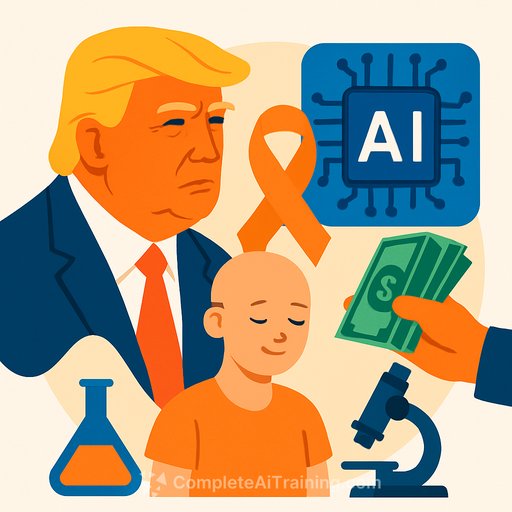Trump Orders Federal Push to Apply AI in Childhood Cancer Research
President Donald Trump signed an order directing the federal government to use artificial intelligence to accelerate childhood cancer research and added $50 million to the National Institutes of Health to support it. The move comes as the administration advances broader cuts that have reduced NIH grant funding and reshaped health agencies.
The order assigns the Make America Healthy Again (MAHA) Commission to work with the Office of Science and Technology Policy (OSTP) on the AI effort. The White House said the funding doubles the NIH childhood cancer data initiative's current investment, with the option for additional allocations later.
What the directive does
The administration framed the order as a data-first strategy: improve collection, integrate existing pediatric oncology datasets, and apply AI to detect patterns that inform diagnostics, treatments, and prevention. OSTP Director Michael Kratsios said the effort could lead to "enhanced diagnostics, optimized treatments and, we hope, new cures."
The MAHA Commission, chaired by Health Secretary Robert F. Kennedy Jr., will coordinate with OSTP. The focus is expected to be practical use of accumulated datasets and expanding the NIH's ongoing childhood cancer data work.
For technical teams, this likely translates to more emphasis on data quality, harmonization across institutions, and reproducible AI workflows that can move from retrospective studies toward trial-enabling evidence.
The broader funding context
The policy shift lands amid significant restructuring. The administration has overhauled the Department of Health and Human Services, laid off researchers, and canceled grants. At NIH, more than $1 billion in agency-funded research grants were cut in the first quarter of the year, including cancer projects, with litigation continuing and the Supreme Court allowing millions in cuts to proceed in August.
The White House has also proposed nearly a 40% reduction to NIH's overall budget, including the National Cancer Institute. A budget standoff in Congress, tied to health spending and subsidies, has raised the prospect of a government shutdown if no agreement is reached.
Implications for scientists and research leaders
- Data integration: Expect pressure to make pediatric oncology data findable, accessible, interoperable, and reusable. Teams with well-documented schemas, ontologies, and de-identification protocols will be better positioned.
- Clinical utility: Projects that link AI outputs to actionable endpoints-risk stratification, trial eligibility, therapy selection, toxicity prediction-will align with stated goals.
- Method rigor: Emphasize external validation, calibration across sites, fairness audits, and drift monitoring. Pediatric populations are small and heterogeneous; overfitting risk is high.
- Privacy and ethics: Tighten consent language for secondary use, ensure HIPAA-compliant pipelines, and transparently describe model behavior to clinicians and families.
- Collaboration: Multi-center consortia and data-sharing agreements can increase statistical power and generalizability. Prepare governance structures and data use agreements now.
- Funding strategy: Monitor NIH for related Funding Opportunity Announcements and Notices of Special Interest in pediatric oncology + AI. Be ready with shovel-ready datasets, clear milestones, and a path to clinical translation.
Key questions to watch
- Will the $50M be new money or reallocated from existing lines, and how will it flow across NIH and NCI programs?
- What standards will govern data quality, interoperability, and model reporting for pediatric cohorts?
- How will access policies be set for any centralized datasets or platforms built under this order?
- Can targeted AI funding offset broader cuts to investigator-initiated grants, and how will this affect paylines?
- What timelines will OSTP and the MAHA Commission set for deliverables and public reporting?
Practical next steps for your team
- Audit your pediatric datasets for completeness, harmonize vocabularies, and publish data dictionaries. Document provenance and consent metadata.
- Stand up secure, audited pipelines for de-identification, PHI handling, and dataset versioning. Include bias and performance monitoring by subpopulation.
- Design prospective validation plans with clinical collaborators. Pre-register analysis where feasible and define decision thresholds tied to clinical impact.
- Prepare concise concept notes that map your assets to likely AI-in-pedi-onc priorities: imaging, genomics, longitudinal EHR, trials enrichment, and survivorship outcomes.
- Engage your IRB early for secondary use and cross-institutional data sharing. Build standard DUAs and governance templates now.
Where to track developments
For data standards and program updates, follow NIH's childhood cancer data efforts and OSTP announcements:
Upskilling for AI in biomedical research
If your lab needs structured training to apply modern AI methods to clinical and omics data, explore curated programs by role and skill level:
Bottom line: the order creates a focused AI on-ramp for pediatric oncology while broader funding remains volatile. Teams that prepare clean data, rigorous methods, and clinical partnerships will be first in line when opportunities open.
Your membership also unlocks:






